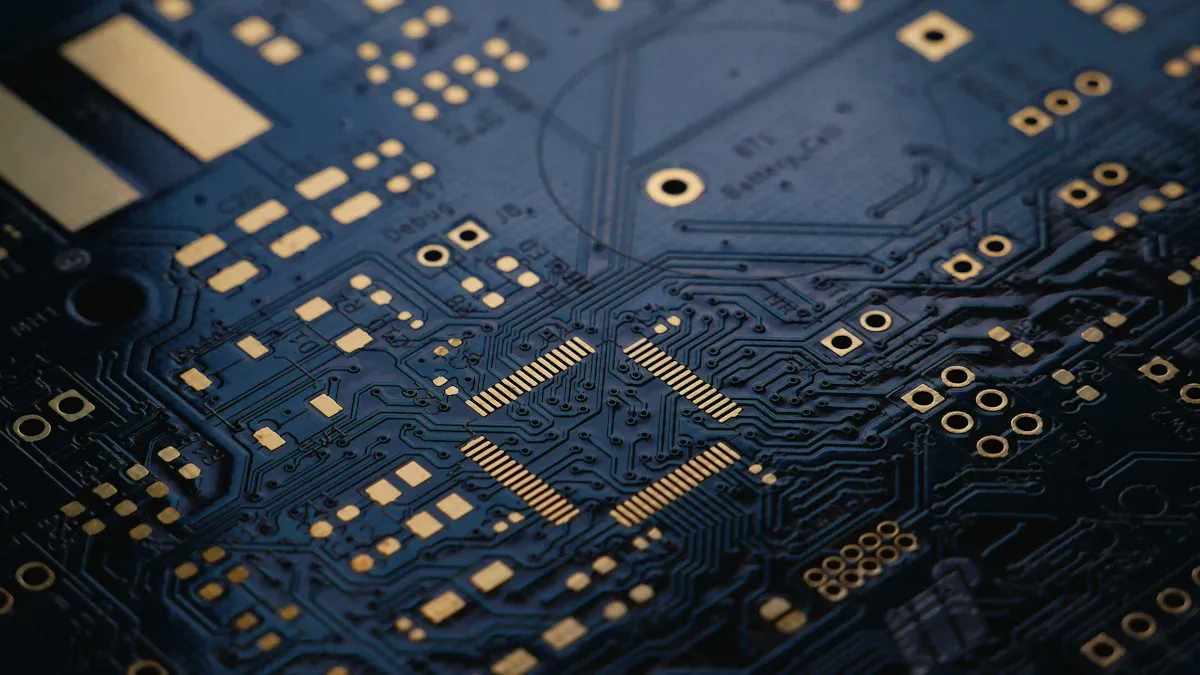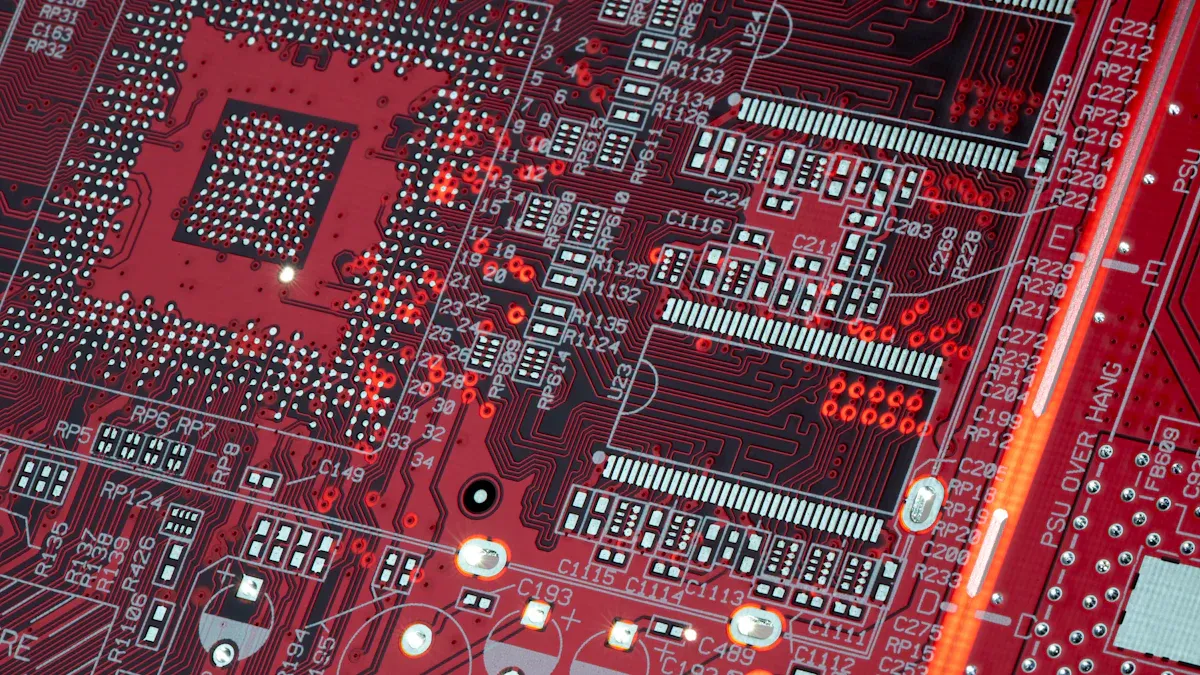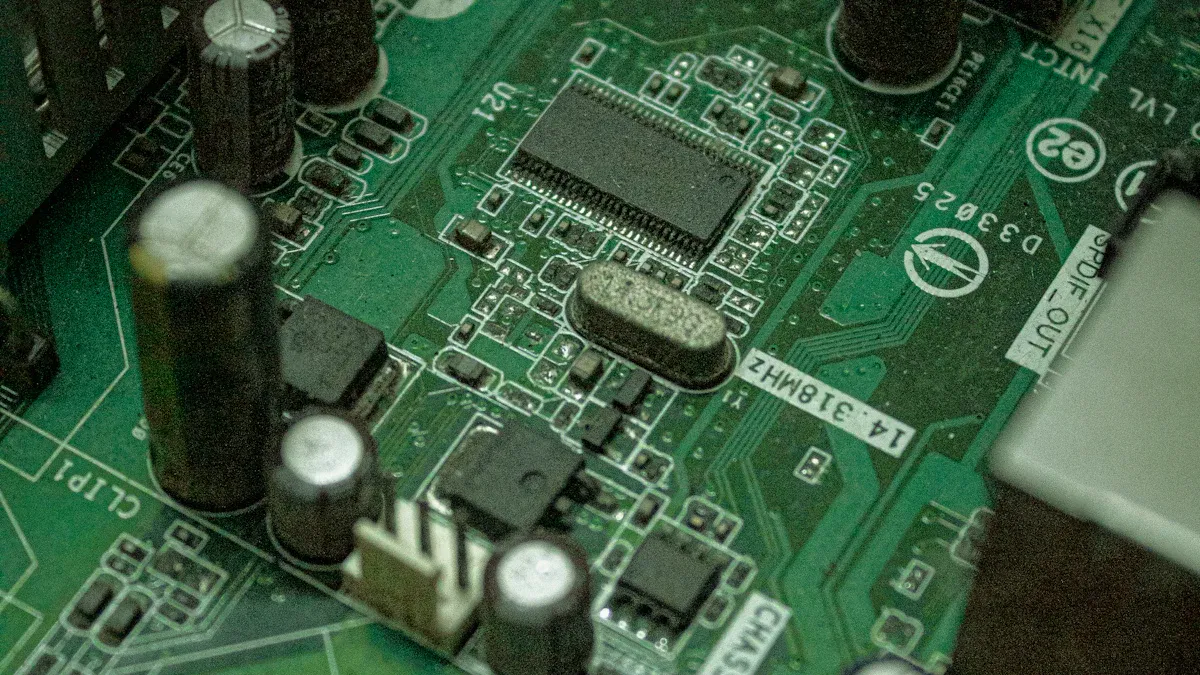How to Combine Rogers Material with TG170 for Hybrid PCBs

Combining a mixed lamination of Rogers material and TG170 results in strong and reliable PCBs. This method enhances signal quality and heat control. Hybrid circuit boards are ideal for fast and high-frequency applications. LT CIRCUIT expertly utilizes the mixed lamination of Rogers material and TG170 to produce precise and high-quality PCBs.
Key Takeaways
Mixing Rogers material with TG170 makes tough and dependable hybrid PCBs, perfect for high-frequency uses.
Rogers material improves signal quality and handles heat well, while TG170 makes the PCB stronger and more affordable.
Pick the right materials and plan layers smartly to get the best performance and long-lasting hybrid PCBs.
Properties of Rogers Material and TG170

Key Features of Rogers Material
Rogers material works great for high-frequency PCBs. It helps keep signals clear and handles heat well. Its dielectric constant stays steady, even at different frequencies. This makes it reliable for sending signals.
Here are some features:
Low Dielectric Loss: Keeps signals strong and reduces distortion.
High Thermal Conductivity: Moves heat away to stop overheating.
Stable Dielectric Constant: Works predictably at high frequencies.
Low Moisture Absorption: Stays strong in humid places.
Rogers material is perfect for hybrid PCBs where signal quality matters.
Key Features of TG170
TG170 is tough and handles heat well. It’s great for strong PCB designs. It can take high temperatures without losing its performance.
Features include:
High Glass Transition Temperature (170°C): Stays stable during heating and cooling.
Superior Mechanical Strength: Makes PCBs durable, especially with many layers.
Good Electrical Insulation: Stops electrical problems for smooth operation.
Cost-Effectiveness: TG170 is affordable and useful for hybrid PCBs.
TG170 is a key part of combining Rogers material and TG170.
Advantages of Mixed Lamination of Rogers Material and TG170
Using Rogers material with TG170 makes hybrid PCBs strong and reliable. Both materials bring their best features together.
Advantages include:
Enhanced Signal Integrity: Rogers keeps signals clear; TG170 adds strength.
Improved Thermal Management: Rogers handles heat; TG170 resists damage from heat.
Cost Efficiency: TG170 saves money in less important layers.
Versatility: Works for complex designs like multilayer PCBs.
Durability: Handles heat and stress for long-lasting use.
Tip: Pick the right layer setup to get the most from Rogers and TG170.
This method helps make PCBs for modern electronics like phones and factory machines.
Designing a Hybrid PCB Stack-Up

Material Selection for Hybrid PCBs
Picking the right materials is key for a good hybrid PCB. Think about how each material works and fits together. Rogers material and TG170 work well as a team, but your choice depends on your design needs.
For instance, Rogers material is great for high-frequency uses. It has low signal loss and a steady dielectric constant. TG170 is strong and affordable, making it perfect for layers that don’t need high-frequency features. By mixing these materials wisely, you can balance cost and performance.
The table below shows important points to think about when choosing materials:
Evidence Description | Key Considerations |
|---|---|
Customizing each layer for specific tasks | Signal clarity, power flow, heat control |
Using materials smartly to save money | Cost savings in large-scale production |
Keeping signals safe from noise | Ground planes and shielding are important |
Picking materials for heat control | Good for high-power designs |
Checking CTE properties | Prevents issues during manufacturing |
Reading material data sheets | Details from manufacturers help in selection |
Choosing the right layer thickness | Avoids problems with high-frequency signals |
Picking bonding materials | Must work well with different materials |
Tip: Always check material data sheets to ensure they match your design and work well together.
Layer Stack-Up Design for Signal Integrity
A good layer setup keeps signals clear in hybrid PCBs. Plan where to place signal, power, and ground layers to reduce noise. Rogers material is best for high-frequency signals, while TG170 suits power and ground layers.
To test your design, use tools and data. For example:
Use SPICE tools to see if parts work together.
Study signal waves to avoid interference.
Follow these steps to improve your design:
Check for noise using special tools to find problem areas.
Look at signal reflections to fix mismatched paths.
By solving these issues, you can make a hybrid PCB that handles fast and high-frequency tasks without losing signal quality.
Thermal Management in Hybrid PCB Designs
Managing heat is very important in hybrid PCBs, especially for high-power or fast devices. Make sure heat moves out of the board to avoid damage.
Rogers material is great for layers that deal with a lot of heat because it spreads heat well. TG170 adds strength by handling heat stress. To improve heat control, try these tips:
Use materials that spread heat well for hot layers.
Add thermal vias to move heat away from hot spots.
Design copper layers to spread heat evenly.
Good heat control makes your PCB last longer and work better under tough conditions.
Note: Always consider the thermal expansion of materials to avoid cracks or bending during use.
Overcoming Challenges in Hybrid PCB Manufacturing
Managing Thermal Expansion in Hybrid PCBs
Heat can make hybrid PCBs expand unevenly. Rogers and TG170 grow differently with heat, causing bending or misalignment. To fix this, pick materials with matching thermal expansion rates (CTE). For example, Tachyon-100G stays stable and avoids damage during heating and cooling cycles.
Changing the layer design also helps control expansion. Each layer can be made for tasks like keeping signals clear or spreading heat. Special materials help manage heat better, especially for powerful devices. The table below shows important design tips:
Aspect | Description |
|---|---|
Customized Stack-Up | Layers designed for better signals, power flow, and heat control. |
Thermal Management | Materials that spread heat well stop overheating. |
Coefficient of Thermal Expansion | Matching CTE values prevents bending during heating and cooling. |
Material Compatibility Testing | Follow IPC rules to pick materials with good Tg, Td, Dk, and CTE. |
Example of CTE Issues | PTFE expands more than FR-4, risking damage during heating. |
Recommended Material | Tachyon-100G stays stable and works well for tricky designs. |
Tip: Test materials to make sure they work well in hot and cold conditions.
Lamination Techniques for Rogers and TG170
Joining Rogers and TG170 layers needs careful lamination. Use bonding materials that stick well to both types. This stops layers from coming apart and keeps the PCB strong.
Heat control is very important during lamination. Rogers material reacts differently to heat, so handle it carefully. Use the right pressure and temperature to avoid damage. Advanced machines help make sure the layers bond evenly, especially for complex designs.
Ensuring Reliable Plating and Drilling Processes
Plating and drilling are key steps in making hybrid PCBs. Plating adds copper layers for smooth electricity flow. Clean surfaces before plating to avoid problems like gaps or uneven layers.
Drilling needs to be precise to protect the layers. Rogers material is softer than TG170, so use special drill bits for accuracy. Adjust drill speed and pressure to avoid damaging the PCB. Check the work often to catch and fix mistakes early.
Note: Good plating and drilling make hybrid PCBs last longer and work better.
Mixing Rogers material with TG170 makes hybrid PCBs perform well. They offer clear signals, good heat control, and strong durability. These PCBs are also affordable for high-frequency uses. Working with LT CIRCUIT gives expert help and precise production. To do well, pick materials that match, design for clear signals, and test carefully while making them.
FAQ
What are the key benefits of hybrid PCBs?
Hybrid PCBs use different materials for better performance. They keep signals clear, control heat well, and save money by using cheaper materials in less important layers.
How do you ensure material compatibility in hybrid PCBs?
Check how materials expand with heat (CTE). Use glue that sticks well to both Rogers and TG170 to stop layers from peeling or bending.
Can hybrid PCBs handle high-frequency applications?
Yes, hybrid PCBs work great for high-frequency tasks. Rogers material keeps signals strong and steady, making it perfect for fast devices.
Tip: Work with skilled makers like LT CIRCUIT for dependable hybrid PCB designs.
See Also
Exploring Rogers R4350B, R4003, And R5880 For RFPCB Use
Key Steps For Efficient Fast Turnkey PCB Assembly
Learn Innovative Techniques For HDI PCB Prototyping Now
An Overview Of Manufacturing Multilayer Rigid-Flex Circuit Boards
